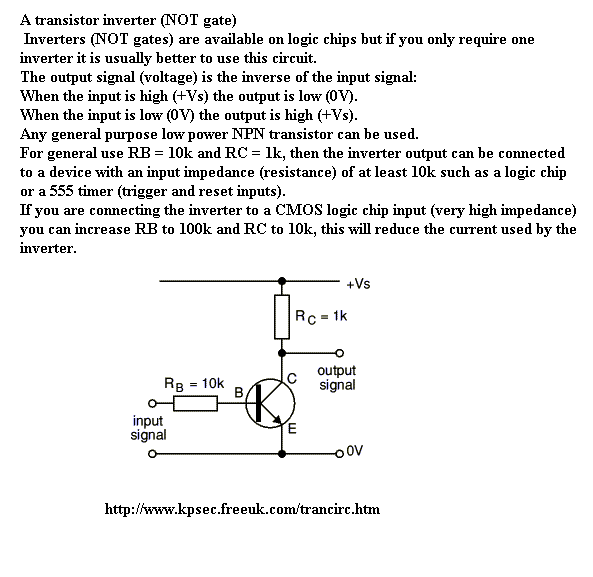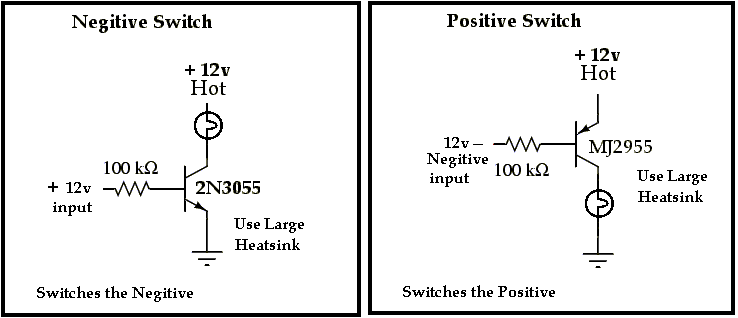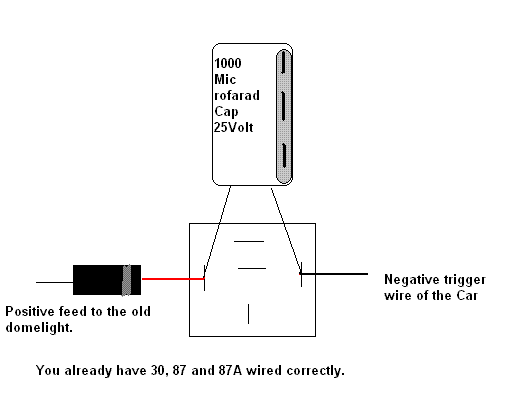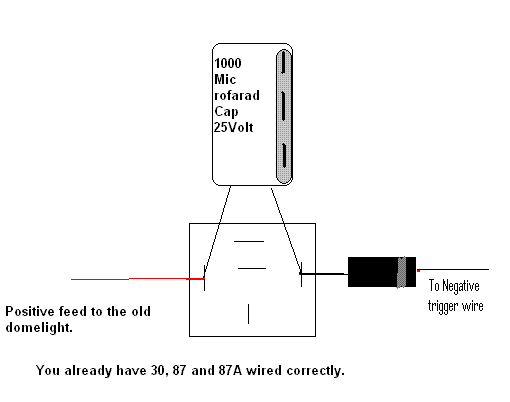Relay Buzzing
Printed From: the12volt.com
Forum Name: Relays
Forum Discription: Relay Diagrams, SPDT Relays, SPST Relays, DPDT Relays, Latching Relays, etc.
URL: https://www.the12volt.com/installbay/forum_posts.asp?tid=114184
Printed Date: January 06, 2026 at 11:03 PM
Topic: Relay Buzzing
Posted By: bellsracer
Subject: Relay Buzzing
Date Posted: June 02, 2009 at 7:40 PM
I have a 03 Saturn ION with an overhead installed on the roof. However, the overhead did not support negative trigger for the dome light. I used a relay to switch the polarity going into the trigger.
It works fine now, but now the relay buzzes every time the dome light turns off. How do I get rid of the buzz?
-------------
Never send your ducks to eagle school.
The difference between ordinary and extraordinary is that little extra.
The 3Ls of life: Learn from the Past, Live for the Present, Look to the Future.
Replies:
Posted By: i am an idiot
Date Posted: June 02, 2009 at 7:51 PM
The relay is chattering as the domelight dims. This will not hurt anything. You could try wrapping the relay with Dynamat or some other sound deadening material. The motor assembly in a Bosch relay is huge as far as relays go. You may try one of these from radio shack, it will be MUCH QUIETER than what you are using. https://www.radioshack.com/product/index.jsp?productid=2062482
Posted By: Ween
Date Posted: June 02, 2009 at 8:24 PM
hi, A diode (1N4001 or equiv) and capacitor(1000uFor so, at least 16V) should do the trick. Capacitor across the coil of the relay you added, pay attention to polarity of course. Diode in series on the domelight lead from the vehicle then to the coil of said relay. Should allow the relay to turn off a little more abruptly. hope this helps, m
Posted By: hotwaterwizard
Date Posted: June 05, 2009 at 8:14 AM
Ween]< wrote:
>hi,A diode (1N4001 or equiv) and capacitor(1000uFor so, at least 16V) should do the trick. Capacitor across the coil of the relay you added, pay attention to polarity of course. Diode in series on the domelight lead from the vehicle then to the coil of said relay. Should allow the relay to turn off a little more abruptly. hope this helps, m
This is what I would do too with a couple more ideas. Do not run the positive and negitive wires together. The EMF from one wire can bleed into the other. Add a 1uF capacitor in series with the positive lead of the Relay. Put the + twards the Relay (if you use a bipolar you don't have to worry about polarity). ------------- John DeRosa (Hotwaterwizard)
Stockton California
When in doubt, try it out !
Posted By: i am an idiot
Date Posted: June 05, 2009 at 3:15 PM
Posted By: KPierson
Date Posted: June 05, 2009 at 4:46 PM
Posted By: dualsport
Date Posted: June 05, 2009 at 7:37 PM
Is the dome light putting out a pulsed dc waveform to do the dimming by changing the duty cycle?
You could verify this is the case by disconnecting the load from your relay, only connecting the coil, and seeing if you get the same buzzing.
The diode and cap suggested by Ween would be something to try if that's the situation. That should smooth out the pulses to keep it from cycling on and off. A buzzing relay generally should be avoided as it's bad for the contacts, shortening the lifespan of the thing.
If the diode and cap isn't enough to smooth it out, adding a buffered transistor driver would do it, at the cost of added complexity-
Posted By: i am an idiot
Date Posted: June 05, 2009 at 8:56 PM
The contacts of a chattering relay are damaged in high current situations. He is using the relay to convert the polarity and power the domelight on the roof of the vehicle. Not seeing the contacts being damaged from the 1/2 amp of current.
Posted By: dualsport
Date Posted: June 05, 2009 at 9:17 PM
Unless the chattering is necessary like in a mechanical horn, there's really no benefit to leaving it that way when it's easily corrected.
Instead of simply muffling it, why not have it just go click once instead of bzzzzzing every time the door closes?
Posted By: KPierson
Date Posted: June 06, 2009 at 6:31 AM
Since there is mechanical movement inside the relay the contacts will be rated for a minium amount of cycles before they wear out. The chatter will reduce the life span of the relay, regardless of the current going through the contacts, but typically the rated cycles is so high that the relay should still outlast the car. There are multiple ways to look at this - you can make it more complicated and actually fix the problem, or you can keep it simple and hide the fact that there is a problem. Me, personally, on something so trivial, I would just throw a reed relay in there - quick and easy and it will no longer be an annoyance. ------------- Kevin Pierson
Posted By: dualsport
Date Posted: June 06, 2009 at 7:38 AM
So far it's just been speculation on what's being switched and the durability of the particular relay he might be using, so we don't really know how long things will last. Hot switching makes it worse, as does higher currents and inductive loads.
Back before solid state, voltage used to be regulated by switching mechanical relays on and off rapidly, before anything better was available. It'll work, and probably last a while, but if it's as simple as adding a couple of components, I'd go that route.
Reed relays are quieter, but the concern is that they tend to be lower power and may actually tend to fail earlier.
What's actually being done here anyway, is the overhead he mentioned a set of added lights or is that referring to the OEM dome light? Is a domelight supervisor being added from some alarm to control the dome light? I was assuming the Saturn Ion he mentioned was doing the dimming, but that was just a WAG on my part. I'm not sure what the problem actually was, that needed this relay for the polarity switching. Or is the problem that he needed a negative trigger for an alarm system, when the dome light was switched from the high side?
If that's the case, then there's no current involved, going into the alarm trigger. If that's all it's for, why not a transistor for an easy fix? It won't have any problems with the rapid switching and should be a bit quieter.
Maybe someone can sketch out the details on what it is we're doing.
Posted By: hotwaterwizard
Date Posted: June 06, 2009 at 12:44 PM
 ------------- John DeRosa (Hotwaterwizard)
Stockton California
When in doubt, try it out !
Posted By: hotwaterwizard
Date Posted: June 06, 2009 at 12:50 PM
 ------------- John DeRosa (Hotwaterwizard)
Stockton California
When in doubt, try it out !
Posted By: bellsracer
Date Posted: June 08, 2009 at 4:48 PM
okay.... where do I begin. First off, I'm female! T-T
So let's please keep that in mind. Thank you Second, here is the situation.
Three wires: 1:12+ / 2:ground / 3:domelight.
ION uses negative trigger for the dome light. Otherwise the wire is 12+ The relay is switching the domelight wire to be a 12+ when needed. However when the lights fade, the relay buzzes. Wizard, I thank you for the diagrams, but I have no idea what they mean. minna tasukette! ------------- Never send your ducks to eagle school.
The difference between ordinary and extraordinary is that little extra.
The 3Ls of life: Learn from the Past, Live for the Present, Look to the Future.
Posted By: i am an idiot
Date Posted: June 08, 2009 at 5:37 PM

Above diagram is a picture of what "Ween" suggested. His idea, my picture. Simply add the capacitor and the diode to your relay. As ween stated, make sure you polarize the capacitor properly. The Diode must go on the positive wire. The banded end of the diode needs to be connected to the relay. When the vehicle drops the voltage to fade the lamp, the cap will keep the relay energized for a second or so. The diode keeps the stored cap voltage from going back into the vehicle.
Posted By: dualsport
Date Posted: June 08, 2009 at 9:18 PM
bellsracer wrote:
First off, I'm female! T-T
So let's please keep that in mind. Thank you
Oops, I was just playing the percentages there, and lost-  I guess the question I should ask is, what is the output of the relay being used for? It sounds like you're not driving the domelight with the relay, because the Ion's doing that, with its dimmer control. If you simply need an inverted signal from the negative switching dome light control to trigger an alarm or something low current like that, you could use one of the circuits Hotwaterwizard to invert it from (-) to (+). As long as it doesn't matter that the (+) signal will have a rapid oscillation during the dimming time, it should work well enough. But, if you're using the relay to drive lights or something needing a good amount of power, then the relay would serve the purpose, and you could try something along the lines of adding Ween's cap and diode as I am an idiot pictured.
Posted By: soundnsecurity
Date Posted: June 10, 2009 at 6:01 PM
bellsracer wrote:
I have a 03 Saturn ION with an overhead installed on the roof. However, the overhead did not support negative trigger for the dome light. I used a relay to switch the polarity going into the trigger.
It works fine now, but now the relay buzzes every time the dome light turns off. How do I get rid of the buzz?
use the door pin to drive a relay for your overhead's lights. it wont follow what the dome light does but it will be on when the door is open and off when the door is closed. not sure what the polarity of your doorpin is but you can just use the same relay to change polarity. -------------
Posted By: dualsport
Date Posted: June 10, 2009 at 8:22 PM
Exactly what are the overhead lights? Are these aftermarket lights or something?
Posted By: i am an idiot
Date Posted: June 10, 2009 at 8:55 PM
She installed an aftermarket flip down monitor with a built in DVD player. There is a domelight built into the unit. That is what the overhead lights are.
Posted By: dualsport
Date Posted: June 10, 2009 at 9:01 PM
Ah, thanks-
Posted By: bellsracer
Date Posted: June 23, 2009 at 3:30 AM
iaai... Thank you so much for the diagram. much better.
sns, I didn't want to use the doorpins because I can't. They are computer trigger controlled and isolated from each other. In other words, royal pain in the rear to get to work.
Minna, honto ni arigatou gozaimasu!
-------------
Never send your ducks to eagle school.
The difference between ordinary and extraordinary is that little extra.
The 3Ls of life: Learn from the Past, Live for the Present, Look to the Future.
Posted By: dualsport
Date Posted: June 23, 2009 at 7:53 AM
i am an idiot wrote:

Above diagram is a picture of what "Ween" suggested. His idea, my picture.
Simply add the capacitor and the diode to your relay. As ween stated, make sure you polarize the capacitor properly. The Diode must go on the positive wire. The banded end of the diode needs to be connected to the relay.
When the vehicle drops the voltage to fade the lamp, the cap will keep the relay energized for a second or so. The diode keeps the stored cap voltage from going back into the vehicle.
If the control line is the negative side, the diode would need to be on the other side of the coil. It sounds like the 12V side is constant from the description of the setup.
Posted By: i am an idiot
Date Posted: June 23, 2009 at 8:17 AM
Thanks for pointing that out Dualsport, I have made changes accordingly. 
------------- Let's Go Brandon Brown. Congratulations on your first Xfinity Series Win. LGBFJB
Posted By: bellsracer
Date Posted: June 23, 2009 at 9:27 PM
Awww... Thank you both of you. That's why I love ya guys!
Jya ne
-------------
Never send your ducks to eagle school.
The difference between ordinary and extraordinary is that little extra.
The 3Ls of life: Learn from the Past, Live for the Present, Look to the Future.
Posted By: dualsport
Date Posted: June 24, 2009 at 9:43 PM
bellsracer wrote:
minna tasukette!
Minna, honto ni arigatou gozaimasu!
Jya ne
Okay, I have to ask.. am I missing a decoder ring or am I just not a cunning linguist? 
Posted By: bellsracer
Date Posted: June 26, 2009 at 10:15 PM
dualsport wrote:
Okay, I have to ask.. am I missing a decoder ring or am I just not a cunning linguist? 
Please turn your subtitles on your screen to Japanese
"
minna tasukette!
(Everyone, HELP!)
Minna, honto ni arigatou gozaimasu!
(Everyone, I really thank you very much)
Jya ne
(See ya) We thank you for your compliance. The preceding closed captioning has been brought to you by BellsRacer in association with Teledon Communications. Please PM for more information (seriously) >.< ------------- Never send your ducks to eagle school.
The difference between ordinary and extraordinary is that little extra.
The 3Ls of life: Learn from the Past, Live for the Present, Look to the Future.
Posted By: petertfm
Date Posted: January 25, 2010 at 6:54 PM
i am an idiot wrote:
Thanks for pointint that out Dualsport, I have made changes accordingly. 
I just wanted to let you know and others that a 1000mic 35 volt capacitor worked great for me!
I used it on a bosch relay, no more buzzing:)
Posted By: zepdad
Date Posted: April 27, 2010 at 10:33 PM
First time poster. Thanks for everyone's hard work. I will use the forum often I can see that now.  I have a similar relay buzzing issue. I think the easiest solution is a reed relay but wanted to check with the experts. My application is for ambient/courtesy light LED's. Very low current draw, maybe 150ma for all LED's. I'm pulling from two diode isolated power sources: (1) Headlight circuit for the ambient lighting effect. No problem with this circuit. Standard 12v switched power and common ground. (2) Map light circuit for the courtesy light (door open) effect. Two minor problems to overcome with this circuit. First, the circuit is controlled by a negative trigger wire. This was easily solved with a relay and the Convert Negative Polarity diagram I found on this site. Second, the map light circuit is not an immediate 12v on/off circuit. There is a rapid voltage rise when door is opened and 30-second dimming effect with slow voltage drop when door closed. The standard auto relay buzzes on door open (briefly) and on dimming (longer). The solutions, as I understand them, are either (a) relay with capacitor and diode, but don't think this will solve the door open buzzing, (b) transistor instead of relay, or (c) quiet relay. Since my application is very low current an inexpensive and quiet reed relay seems to make the most sense. Questions: Is Radio Shack's .5 amp 275-233 Reed Relay sufficient for my needs? Or would you recommend another brand? What is the proper wiring? (Why won't Radio Shack provide spec sheets?) Is a reed relay numbered with standard 30-85-86-87-87a terminals or is it a D pinout used in mini relays? I found this conversion on another site. 1=86, 2=85, 3=30, 4=87a, 5=87 for the D pinout. Please confirm or point me in the right direction to wire the reed relay. Thanks again.
Posted By: i am an idiot
Date Posted: April 27, 2010 at 10:57 PM
There should be a diagram or something that comes with it. 85 and 86 are the coil connections on a numbered relay. There should be a coil drawn between the 2 connections that you will sub 85 and 86. The other 2 connections are the same as 30 and 87.
Posted By: KPierson
Date Posted: April 28, 2010 at 5:49 AM
The pins make a cross shape:
____A
__B___C
_
_
____D
B and C are the coil pins and A and D are the contacts. The letters are just for illustration, they are not standard and won't be on the relay.
-------------
Kevin Pierson
Posted By: zepdad
Date Posted: April 28, 2010 at 6:37 AM
Looking at the picture on Radio Shack's site I can see the cross shape. Easy enough. I'll pick up the relay in the next day or two and post my results. Thanks
Posted By: howie ll
Date Posted: April 28, 2010 at 4:29 PM
My tuppence worth first, Craig, how much for those bloody relays? I pay 60c. each for 10 plus from RS Components in the UK (I think Farnell in the US is part of their organisation).
Second I'm assuming draw is 1 amp per light bulb for incandescent bulbs assuming 10watt each rating. Why not use a power transistor + 1N 4004 + 50k resistor, it's pennies. I humbly admit to not remembering the circuit but I'm sure both you Craig and Kevin P. know what I mean, I believe one of you published it here.
Posted By: zepdad
Date Posted: April 29, 2010 at 8:30 AM
Completed initial testing with reed relay. Works as advertised, very quiet with nearly imperceptible buzzing during voltage rise/fall. Mounted underdash it should work well for my application. Was talking with an electronics expert and he suggested I reconsider the transistor setup. It will give nice feedback of the voltage rise/fall and be completely noise free, maybe with longer life. The only concern would be heat. Any idea how much heat a low voltage LED setup would generate through the transistor? Maybe 150ma total current, no more than 200ma. Would I need to heat sink the transistor or is it of little concern in my application?
Posted By: zepdad
Date Posted: May 16, 2010 at 7:16 AM
This may have been posted before but I located an excellent solid state relay for auto applications, the Hongfa HFS33. Silent, with easy screw terminals. Rugged construction and no heat with my low voltage LED install. Much better than the fragile reed relay (yes, I broke two reeds simply trying to wire and shrink wrap). More expensive at $25 shipped but well worth it IMHO. Manufacturer product page https://www.hongfa.com/pro/HFS33_en.html Article discussing use https://autospeed.co.nz/cms/title_Using-Solid-State-Relays/A_110574/article.html Web store https://www.futurlec.com/Relays/SSRDC100V40A.shtml [Note: This is only online retailer I could find. Relay is shipped direct from Taiwan, took about 10 days. No problem with Futurlec, order handled professionally.]
|






